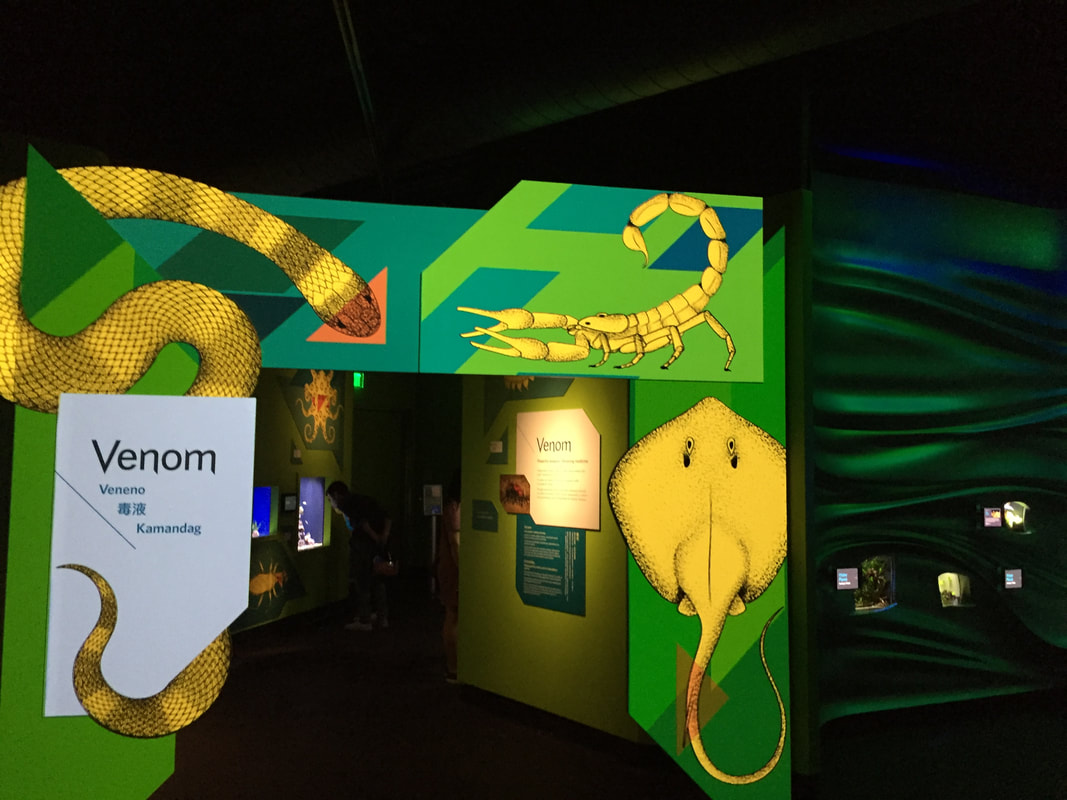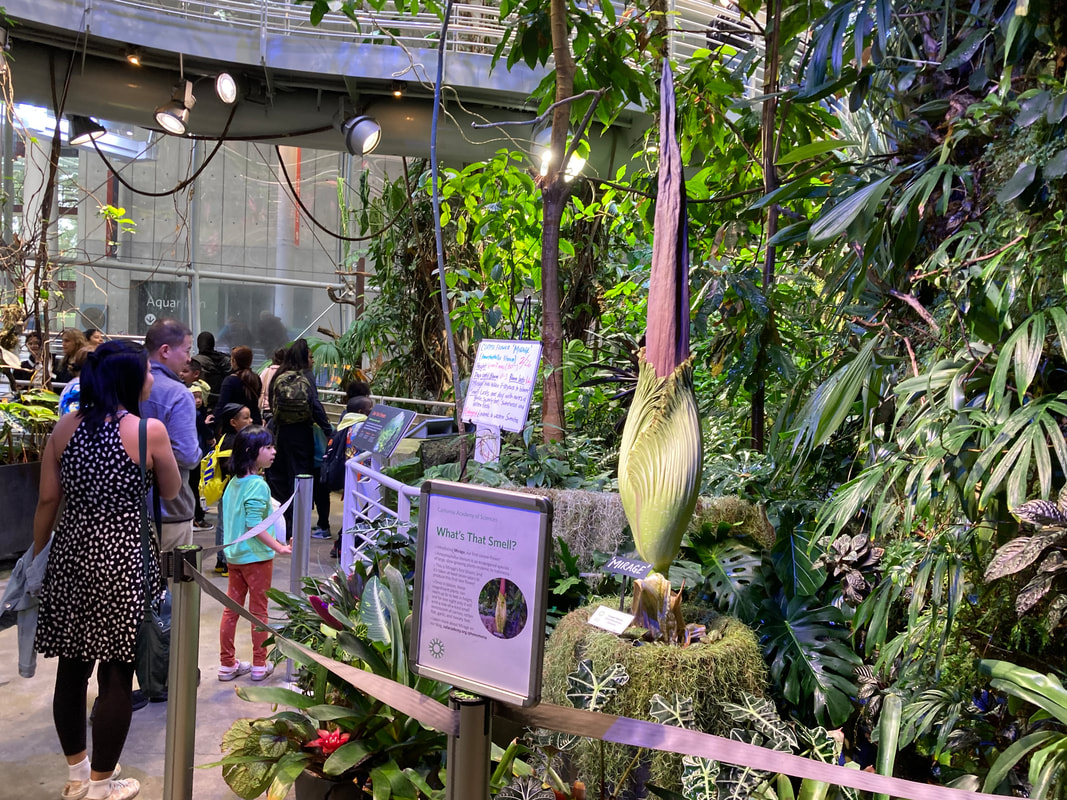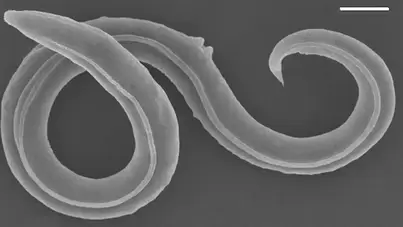Stinking plant has a following
Visitors to the Osher Rainforest encounter the unique corpse flower. Dave Boitano/photo
Feb. 27, 2024
What flower takes five years to grow, can reach 10 feet high and smells like a dead body?
The answer is found this week in the humid Osher Rainforest at the California Academy of Sciences.
Meet Amorphophallus titanum, or the corpse flower. It’s a rare plant native to the Indonesian rainforests, which despite its strange growth cycle, is a hit with audiences.
Its name comes from the foul odor the flower gives off when it blooms for only a few days after a five-year growth cycle.
The stench has been described as a combination of rotting onions and cabbage, garlic, sweaty socks and a decomposing human body. Not the kind of bud you would want in your rose garden. While such a scent repulses most people, it attracts carrion beetles and flies that the plant needs to pollinate.
The academy’s plant, dubbed “Mirage,” was donated by the nearby Conservatory of Flowers in 2017 and moved into the Osher rainforest in December of 2020. Visitors to the conservatory can see other such tropical plants in a sweltering room designed to recreate a jungle-like environment.
Academy biologists have been nurturing the plant for the past five years and measuring its height. It went through a growth spurt recently and scientists think it will grow to between five and seven feet. That’s a bit shorter than the 10 feet corpse flowers can reach in the wild.
Native to the island of Sumatra, the odiferous offering is endangered, with less than 1,000 plants surviving in their original habitat, according to the IUCN Red List.
The flower opened its tightly-bound leaves on Tuesday, Feb. 27 and will spread its nauseating scent for only 24 hours or so, academy officials said. Due to the amount of energy needed to flower, Mirage take another two to three years to bloom again or may never reopen.
What flower takes five years to grow, can reach 10 feet high and smells like a dead body?
The answer is found this week in the humid Osher Rainforest at the California Academy of Sciences.
Meet Amorphophallus titanum, or the corpse flower. It’s a rare plant native to the Indonesian rainforests, which despite its strange growth cycle, is a hit with audiences.
Its name comes from the foul odor the flower gives off when it blooms for only a few days after a five-year growth cycle.
The stench has been described as a combination of rotting onions and cabbage, garlic, sweaty socks and a decomposing human body. Not the kind of bud you would want in your rose garden. While such a scent repulses most people, it attracts carrion beetles and flies that the plant needs to pollinate.
The academy’s plant, dubbed “Mirage,” was donated by the nearby Conservatory of Flowers in 2017 and moved into the Osher rainforest in December of 2020. Visitors to the conservatory can see other such tropical plants in a sweltering room designed to recreate a jungle-like environment.
Academy biologists have been nurturing the plant for the past five years and measuring its height. It went through a growth spurt recently and scientists think it will grow to between five and seven feet. That’s a bit shorter than the 10 feet corpse flowers can reach in the wild.
Native to the island of Sumatra, the odiferous offering is endangered, with less than 1,000 plants surviving in their original habitat, according to the IUCN Red List.
The flower opened its tightly-bound leaves on Tuesday, Feb. 27 and will spread its nauseating scent for only 24 hours or so, academy officials said. Due to the amount of energy needed to flower, Mirage take another two to three years to bloom again or may never reopen.
Scientists revive ancient worm
Aug. 2, 2023
In what is sure to be breakthrough research, scientists have revived a worm that was frozen more than 47,000 years ago.
The roundworm was an unknown species and was discovered 131 feet down in permafrost in Siberia, Russia. It remained dormant in a state of cryptobiosis, said Professor Teymuras Kurzhalia of the Max Plank Institute of Cellular Biology.
Organisms that enter a cryptobiosis can survive without water or oxygen, can survive high temperatures, freezing and even salty conditions.
They remain in a condition between life and death while their metabolic rates or almost undetectable, Kurzchalia told CNN.
“One can halt life and then start it from the beginning,” he said. The researchers found the worms five years ago and two of them were rehydrated with water before being brought to Germany.
Scientists aged the animals using radiocarbon dating of plant material to determine that the surrounding soil deposits had not been thawed since 45,000 to 47,000 years ago.
The millennia, known as the Upper Paleolithic, included early humans and animals such as the wooly mammoth and the saber-toothed tiger.
In what is sure to be breakthrough research, scientists have revived a worm that was frozen more than 47,000 years ago.
The roundworm was an unknown species and was discovered 131 feet down in permafrost in Siberia, Russia. It remained dormant in a state of cryptobiosis, said Professor Teymuras Kurzhalia of the Max Plank Institute of Cellular Biology.
Organisms that enter a cryptobiosis can survive without water or oxygen, can survive high temperatures, freezing and even salty conditions.
They remain in a condition between life and death while their metabolic rates or almost undetectable, Kurzchalia told CNN.
“One can halt life and then start it from the beginning,” he said. The researchers found the worms five years ago and two of them were rehydrated with water before being brought to Germany.
Scientists aged the animals using radiocarbon dating of plant material to determine that the surrounding soil deposits had not been thawed since 45,000 to 47,000 years ago.
The millennia, known as the Upper Paleolithic, included early humans and animals such as the wooly mammoth and the saber-toothed tiger.
Fusion energy takes giant step forward
Dec. 13, 2022
Research into clean fusion-based energy passed a significant milestone this month as scientists were able to output fusion power in a laboratory.
For the first time ever, scientists at the Lawrence Livermore National Laboratory were able to create more fusion energy than it takes to start the reaction. The experiment took place on Dec.5 but, officials of the lab and the federal Department of Energy announced the results Tuesday.
The announcement has sparked new interest in fusion as a clean alternative to the carbon-based energy that has caused global warming. Energy officials and the administration of President Joe Biden were effusive in their praise.
“Simply put, this is the most impressive scientific feat of the 21st century,” said Energy Secretary Jennifer M. Granholm.
Within the sun and other stars, fusion reactions create enormous light and heat by continually combining hydrogen atoms into helium.
Researchers worldwide have attempted to recreate this process which could be used in power plants. But the results were disappointing, because the experiments consumed more energy than the fusion reactions generated, according to the New York Times.
All that changed when scientists at the National Ignition Facility aimed 192 giant lasers onto a minute hydrogen pellet and pressed the button. The ensuing blast-equal to a pound of TNT-lasted only 100 trillionths of a second, but produced 3 megajoules of energy; 1.5 more than the 2.05 megajoules used to start the ignition. The experiment was a success.
“You see one diagnostic and you think maybe that’s not real and then you start to see more and more diagnostics rolling in,” said Livermore researcher Annie Kritcher, “It’s a great feeling.”
The ignition facility is the size of a small sports stadium. In addition to energy research, the NIF’s powerful lasers are used to recreate the explosive power of America’s nuclear weapons. This allows the energy department to measure the nation’s nuclear deterrent without resorting to underground tests.
Despite the breakthrough, it will take much more research to produce enough fusion energy to replace current global power sources.
“Probably decades,” said Lawrence Livermore Director Kimberly S Budil. “Not six decades, I don’t think. I think not five decades which is what we used to say. I think it’s moving into the foreground and probably with concerted effort and investment, a few decades of research on the underlying technologies could put us into position to build a power plant.”
Research into clean fusion-based energy passed a significant milestone this month as scientists were able to output fusion power in a laboratory.
For the first time ever, scientists at the Lawrence Livermore National Laboratory were able to create more fusion energy than it takes to start the reaction. The experiment took place on Dec.5 but, officials of the lab and the federal Department of Energy announced the results Tuesday.
The announcement has sparked new interest in fusion as a clean alternative to the carbon-based energy that has caused global warming. Energy officials and the administration of President Joe Biden were effusive in their praise.
“Simply put, this is the most impressive scientific feat of the 21st century,” said Energy Secretary Jennifer M. Granholm.
Within the sun and other stars, fusion reactions create enormous light and heat by continually combining hydrogen atoms into helium.
Researchers worldwide have attempted to recreate this process which could be used in power plants. But the results were disappointing, because the experiments consumed more energy than the fusion reactions generated, according to the New York Times.
All that changed when scientists at the National Ignition Facility aimed 192 giant lasers onto a minute hydrogen pellet and pressed the button. The ensuing blast-equal to a pound of TNT-lasted only 100 trillionths of a second, but produced 3 megajoules of energy; 1.5 more than the 2.05 megajoules used to start the ignition. The experiment was a success.
“You see one diagnostic and you think maybe that’s not real and then you start to see more and more diagnostics rolling in,” said Livermore researcher Annie Kritcher, “It’s a great feeling.”
The ignition facility is the size of a small sports stadium. In addition to energy research, the NIF’s powerful lasers are used to recreate the explosive power of America’s nuclear weapons. This allows the energy department to measure the nation’s nuclear deterrent without resorting to underground tests.
Despite the breakthrough, it will take much more research to produce enough fusion energy to replace current global power sources.
“Probably decades,” said Lawrence Livermore Director Kimberly S Budil. “Not six decades, I don’t think. I think not five decades which is what we used to say. I think it’s moving into the foreground and probably with concerted effort and investment, a few decades of research on the underlying technologies could put us into position to build a power plant.”
Jane Goodall inspires environmentally-conscious students
Dave Boitano/photo Jane Goodall speaks to students at the Oakland Zoo
Oct.6, 2022
There was an atmosphere of anticipation at the Oakland Zoo as an invited crowd of students waited to see a living legend.
Moments later, the students and zoo staff, above the zoo’s large open meadow, burst into applause.
Shouts of “We love you Jane,” erupted as Jane Goodall arrived at the tented venue in a golf cart driven by zoo Chief Executive Officer Nik Dehejia.
In introducing Goodall, Dehejia lauded her legendary work and status as a “true global icon.”
Goodall accepted the praise with a sense of humility, telling the students “the one standing before you is just plain Jane.”
At almost 86 years old, Goodall is a seminal figure in the world of animal behavior, global conservation and environmental activism.
Her soft-spoken narration and familiar pony tail make her instantly recognizable to anyone who has watched National Geographic documentaries with titles like “Miss Goodall and the Wild Chimpanzees.” Though she has since become famous, in many ways Goodall is still that young woman in khaki that went to Africa in 1960 to study animals.
She came to the zoo on behalf of “Roots and Shoots,” a global program designed to get youth involved in saving the planet through individual projects no matter how small. Oakland Zoo is part of the Root and Shoots program, and many of the assembled students, from a variety of Bay Area schools are taking part.
Goodall spent her childhood in England reading books about animals and enjoying the company of a neighboring dog, Rusty. Her mother encouraged Goodall’s interest in animals and later accompanied her to Africa.
Working as a waitress in Great Britain, Goodall saved up enough money for an African trip, arriving in Kenya in 1957. She only had enough money for six months but met the well-known anthropologist Louis Leakey who helped raise funds through National Geographic to extend Goodall’s work.
By 1960, Goodall was a primatologist studying a troop of chimpanzees in Tanzania’s Gombe Stream National Park. The animals were shy at first, but one chimp, whom she later named “David Graybeard,” approached her and the others soon followed suit. Her studies of the chimps would yield numerous insights about the animals, their behavior and survival.
By watching Greybeard one day use blades of grass to pick up termites to eat, Goodall made a major discovery: that animals were capable of using tools.
After receiving her doctorate, Goodall later returned to Gombe and opened up a research station.
She was clearly in her element.
“Those were the best days of my life,” she said. “I could spend hours in the rainforest. I got to know the plants and animals that make up the forest ecosystem.”
Her method of giving human names to the animals and focusing on their personalities did not sit well with the august male-dominated world of British primatology.
“I could not talk about their minds, I could not talk about their emotions. I was told that I could not show empathy to the chimpanzees I was studying. Scientists must be coldly objective.”
But Goodall persevered.
“I stood up for my beliefs,” she said. “I didn’t argue with the professors. I just kept on writing about things the way they were.”
While chimpanzees were capable of kindness, Goodall discovered that they had a dark side as well. Chimps can be aggressive at times and even go to war against other groups, like their human counterparts.
By 1986, as the population of chimpanzees was declining, Goodall widened her activities to focus on conservation and aiding humanity. Impoverished Africans were hunting animals for “bush meat, “while clearing rainforests to plant crops and make charcoal for cooking.
Losing rainforest land and the animals that inhabit it can have long-term consequences, Goodall said.
“To me it’s like a tapestry,” she said. “Every time a species disappears from the environment, it’s like pulling a thread from that tapestry. If enough threads are pulled from that ecosystem, it will collapse.”
She started a program to help alleviate poverty, while teaching locals that the environment was just as important to them as to outsiders. The emphasis was on letting people who live near the rainforests make decisions on land use without outside interference.
“The program is still led by local communities and they are not dictated to by a bunch of arrogant white people,” she said.
“Roots and Shoots” began in 1991 when Goodall became aware that young people were angry about the degrading of the environment, but felt helpless to improve the situation. The program is now in 63 countries and involves volunteers from preschoolers age to college students.
The name exemplifies the empowerment students can achieve by not giving up. It’s similar to the struggle a simple seed endures to overcome obstacles and eventually become a tall tree.
“There is a life force, a power in that seed,” she said. “Those little roots can work their way through rocks and gently push them aside and that little shoot on its way to the sun can work its way through a brick wall and eventually knock it down.”
Animal rights activists have criticized zoos for keeping animals locked up and away from their natural environments.
But Goodall disagrees.
“I have been to places where any animal living in the wild is living a life of fear and terror,” she said, “Where they are cutting down the trees and where there are hunters with their bullets. So a good zoo like this is a much better place for animals to live.”
“You are all very lucky to be within travelling distance of a zoo that is as good as this one,” she told the students.
There was an atmosphere of anticipation at the Oakland Zoo as an invited crowd of students waited to see a living legend.
Moments later, the students and zoo staff, above the zoo’s large open meadow, burst into applause.
Shouts of “We love you Jane,” erupted as Jane Goodall arrived at the tented venue in a golf cart driven by zoo Chief Executive Officer Nik Dehejia.
In introducing Goodall, Dehejia lauded her legendary work and status as a “true global icon.”
Goodall accepted the praise with a sense of humility, telling the students “the one standing before you is just plain Jane.”
At almost 86 years old, Goodall is a seminal figure in the world of animal behavior, global conservation and environmental activism.
Her soft-spoken narration and familiar pony tail make her instantly recognizable to anyone who has watched National Geographic documentaries with titles like “Miss Goodall and the Wild Chimpanzees.” Though she has since become famous, in many ways Goodall is still that young woman in khaki that went to Africa in 1960 to study animals.
She came to the zoo on behalf of “Roots and Shoots,” a global program designed to get youth involved in saving the planet through individual projects no matter how small. Oakland Zoo is part of the Root and Shoots program, and many of the assembled students, from a variety of Bay Area schools are taking part.
Goodall spent her childhood in England reading books about animals and enjoying the company of a neighboring dog, Rusty. Her mother encouraged Goodall’s interest in animals and later accompanied her to Africa.
Working as a waitress in Great Britain, Goodall saved up enough money for an African trip, arriving in Kenya in 1957. She only had enough money for six months but met the well-known anthropologist Louis Leakey who helped raise funds through National Geographic to extend Goodall’s work.
By 1960, Goodall was a primatologist studying a troop of chimpanzees in Tanzania’s Gombe Stream National Park. The animals were shy at first, but one chimp, whom she later named “David Graybeard,” approached her and the others soon followed suit. Her studies of the chimps would yield numerous insights about the animals, their behavior and survival.
By watching Greybeard one day use blades of grass to pick up termites to eat, Goodall made a major discovery: that animals were capable of using tools.
After receiving her doctorate, Goodall later returned to Gombe and opened up a research station.
She was clearly in her element.
“Those were the best days of my life,” she said. “I could spend hours in the rainforest. I got to know the plants and animals that make up the forest ecosystem.”
Her method of giving human names to the animals and focusing on their personalities did not sit well with the august male-dominated world of British primatology.
“I could not talk about their minds, I could not talk about their emotions. I was told that I could not show empathy to the chimpanzees I was studying. Scientists must be coldly objective.”
But Goodall persevered.
“I stood up for my beliefs,” she said. “I didn’t argue with the professors. I just kept on writing about things the way they were.”
While chimpanzees were capable of kindness, Goodall discovered that they had a dark side as well. Chimps can be aggressive at times and even go to war against other groups, like their human counterparts.
By 1986, as the population of chimpanzees was declining, Goodall widened her activities to focus on conservation and aiding humanity. Impoverished Africans were hunting animals for “bush meat, “while clearing rainforests to plant crops and make charcoal for cooking.
Losing rainforest land and the animals that inhabit it can have long-term consequences, Goodall said.
“To me it’s like a tapestry,” she said. “Every time a species disappears from the environment, it’s like pulling a thread from that tapestry. If enough threads are pulled from that ecosystem, it will collapse.”
She started a program to help alleviate poverty, while teaching locals that the environment was just as important to them as to outsiders. The emphasis was on letting people who live near the rainforests make decisions on land use without outside interference.
“The program is still led by local communities and they are not dictated to by a bunch of arrogant white people,” she said.
“Roots and Shoots” began in 1991 when Goodall became aware that young people were angry about the degrading of the environment, but felt helpless to improve the situation. The program is now in 63 countries and involves volunteers from preschoolers age to college students.
The name exemplifies the empowerment students can achieve by not giving up. It’s similar to the struggle a simple seed endures to overcome obstacles and eventually become a tall tree.
“There is a life force, a power in that seed,” she said. “Those little roots can work their way through rocks and gently push them aside and that little shoot on its way to the sun can work its way through a brick wall and eventually knock it down.”
Animal rights activists have criticized zoos for keeping animals locked up and away from their natural environments.
But Goodall disagrees.
“I have been to places where any animal living in the wild is living a life of fear and terror,” she said, “Where they are cutting down the trees and where there are hunters with their bullets. So a good zoo like this is a much better place for animals to live.”
“You are all very lucky to be within travelling distance of a zoo that is as good as this one,” she told the students.
Dinosaurs live again in Attenborough production
David Attenborough is known for narrating documentaries featuring a wide variety of the earth’s animals. He is used to describing living creatures, but his latest natural history venture features beasts that died millions of years ago.
Not that it matters. Viewers of “Prehistoric Planet” will be just as moved by the plight of a baby T-Rex as that cute penguin that gets devoured by a leopard seal in one of Attenborough’s typical ventures.
Now being streamed on Apple+, “Prehistoric Planet’ is the latest offering by the British Broadcasting Corporation’s Natural History Unit.
Known for other popular documentaries like The “Blue Planet” and “Planet Earth,“ the division produces 100 hours of wildlife film and 50 hours of radio shows per year, for distribution on BBC’s domestic channels and private cable networks.
Breathtaking photography and film crews that are willing to spend time in often dangerous places, populated by wild animals, is a hallmark of the unit. Add Attenborough’s mixture of scientific narration mixed with enthusiastic anthropomorphism and you have a formula that has made BBC animal shows a worldwide runaway sensation.
Applying that method to beasts we mostly know only as browning skeletons in a natural history display is a major challenge.
But thanks to the latest computer-enhanced graphics, these Cretaceous Period animals move smoothly through their environment, mimicking the traits of today’s mammals and marine creatures.
The show’s producers claim the dino images and behavior are based on the latest paleontological evidence. In reality, some of the scenes must be conjecture given that none of today’s researchers were around eons ago to observe these creatures first hand.
But that doesn’t get in the way of a good story, whether it’s a male T-Rex swimming to a distant island along with his brood of baby tyrannosaurs or a pair of enormous sauropods locked in a fatal fight.
Spoiler alert: the older male gets knocked to the ground and killed, only to become a carcass capable of feeding other prehistoric predators. Life was tough 60 million years ago.
And then there’s Attenborough himself. His presence alone is enough to convince us that everything we are seeing is true; no mean accomplishment in an era when science itself is being doubted.
A British friend once described Attenborough as a national treasure and this latest production bears that out.
As with other history unit presentations, “Prehistoric Planet’s production values help sell the series. The show’s moody soundtrack was created by a team that included Hollywood composer Hans Zimmer and the executive producers include Jon Favreau who created Disney’s popular sci-fi show, “The Mandalorian.”
Along with the five-episode series, viewers can learn more about the latest dinosaur research on the show’s website and even buy fossils on the site’s store.
Sure, there are plenty of show about the land before time, but “Prehistoric Planet” has enough going for it that it’s worth $4.99 for a subscription to Apple+ just to watch it.
For more on the show, visit the “Prehistoric Planet” website. Apple+ subscription terms and information on the site’s other streaming shows can be found here.
Not that it matters. Viewers of “Prehistoric Planet” will be just as moved by the plight of a baby T-Rex as that cute penguin that gets devoured by a leopard seal in one of Attenborough’s typical ventures.
Now being streamed on Apple+, “Prehistoric Planet’ is the latest offering by the British Broadcasting Corporation’s Natural History Unit.
Known for other popular documentaries like The “Blue Planet” and “Planet Earth,“ the division produces 100 hours of wildlife film and 50 hours of radio shows per year, for distribution on BBC’s domestic channels and private cable networks.
Breathtaking photography and film crews that are willing to spend time in often dangerous places, populated by wild animals, is a hallmark of the unit. Add Attenborough’s mixture of scientific narration mixed with enthusiastic anthropomorphism and you have a formula that has made BBC animal shows a worldwide runaway sensation.
Applying that method to beasts we mostly know only as browning skeletons in a natural history display is a major challenge.
But thanks to the latest computer-enhanced graphics, these Cretaceous Period animals move smoothly through their environment, mimicking the traits of today’s mammals and marine creatures.
The show’s producers claim the dino images and behavior are based on the latest paleontological evidence. In reality, some of the scenes must be conjecture given that none of today’s researchers were around eons ago to observe these creatures first hand.
But that doesn’t get in the way of a good story, whether it’s a male T-Rex swimming to a distant island along with his brood of baby tyrannosaurs or a pair of enormous sauropods locked in a fatal fight.
Spoiler alert: the older male gets knocked to the ground and killed, only to become a carcass capable of feeding other prehistoric predators. Life was tough 60 million years ago.
And then there’s Attenborough himself. His presence alone is enough to convince us that everything we are seeing is true; no mean accomplishment in an era when science itself is being doubted.
A British friend once described Attenborough as a national treasure and this latest production bears that out.
As with other history unit presentations, “Prehistoric Planet’s production values help sell the series. The show’s moody soundtrack was created by a team that included Hollywood composer Hans Zimmer and the executive producers include Jon Favreau who created Disney’s popular sci-fi show, “The Mandalorian.”
Along with the five-episode series, viewers can learn more about the latest dinosaur research on the show’s website and even buy fossils on the site’s store.
Sure, there are plenty of show about the land before time, but “Prehistoric Planet” has enough going for it that it’s worth $4.99 for a subscription to Apple+ just to watch it.
For more on the show, visit the “Prehistoric Planet” website. Apple+ subscription terms and information on the site’s other streaming shows can be found here.
Venom is scary but holds promise for medical treatment

An exhibit now showing at the California Academy of Sciences explores a substance most of us would rather avoid: venom.
The painful and sometimes fatal chemical found in many animals is the dark side of nature; creatures inject it into victims to keep from being killed or to subdue their prey.
But “Venom: Fangs, Stingers, and Spines” is not all bad news. The chemistry found in snakebites, for example, can lower blood pressure and researchers are finding more medicinal spinoffs from the compounds found in these toxic secretions.
Venom is defined as any poisonous compound secreted by an animal intended to harm or disable another. The substance must be injected into the victim from a stinger like a bee or sharp fangs like those found in snakes. As with so much in nature there are exceptions such as spitting snakes that can transmit deadly liquids by spitting it into the eyes of prey.
Many people use the term poisonous incorrectly to describe venomous creatures. Poisonous animals must be eaten or otherwise ingested to cause harm.
To date, between 175,000 and 200,000 venomous creatures have been identified by science. They run the gamut from spiders and scorpions, sea snakes and their terrestrial kin and even one species of octopus.
The exhibit contains a variety of venomous creatures including a jellyfish, spider, a nest of bees and even coral. It also mentions research into cures that are being found by bio medical researchers exploring the chemistry of venom.
“There are things about venom that are being explored for a wide range of therapeutics including pain killers, nervous system disorders or infections that have become resistant to traditional antibiotics,” said Lauren Esposito, an academy entomologist who is featured in the exhibit.
For more on Lauren, visit Meet the Scientists
The painful and sometimes fatal chemical found in many animals is the dark side of nature; creatures inject it into victims to keep from being killed or to subdue their prey.
But “Venom: Fangs, Stingers, and Spines” is not all bad news. The chemistry found in snakebites, for example, can lower blood pressure and researchers are finding more medicinal spinoffs from the compounds found in these toxic secretions.
Venom is defined as any poisonous compound secreted by an animal intended to harm or disable another. The substance must be injected into the victim from a stinger like a bee or sharp fangs like those found in snakes. As with so much in nature there are exceptions such as spitting snakes that can transmit deadly liquids by spitting it into the eyes of prey.
Many people use the term poisonous incorrectly to describe venomous creatures. Poisonous animals must be eaten or otherwise ingested to cause harm.
To date, between 175,000 and 200,000 venomous creatures have been identified by science. They run the gamut from spiders and scorpions, sea snakes and their terrestrial kin and even one species of octopus.
The exhibit contains a variety of venomous creatures including a jellyfish, spider, a nest of bees and even coral. It also mentions research into cures that are being found by bio medical researchers exploring the chemistry of venom.
“There are things about venom that are being explored for a wide range of therapeutics including pain killers, nervous system disorders or infections that have become resistant to traditional antibiotics,” said Lauren Esposito, an academy entomologist who is featured in the exhibit.
For more on Lauren, visit Meet the Scientists





